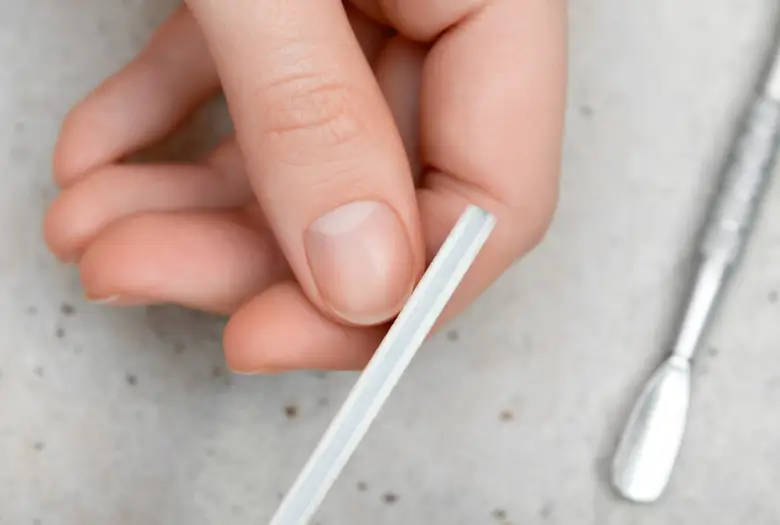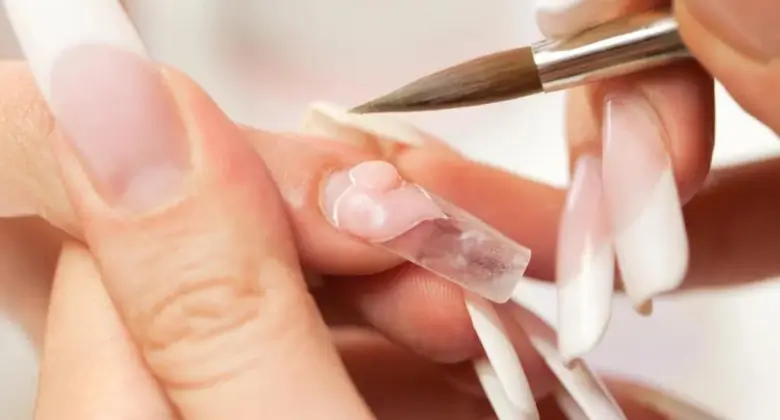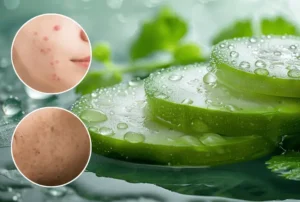Email Us: homeremediesskincare@gmail.com
How to Deal with an Infected Broken Acrylic Nail?

It takes so much time and care to get acrylic nails looking perfect, and they do make your hands look stunning. When one breaks, It can be incredibly frustrating—and if it gets infected, it’s even worse. Suddenly, your beautiful nails are causing you pain and worry. And you know, there are simple and effective ways to handle this.
In this article, I’ll guide you through easy steps to treat and repair infected, broken acrylic nails, You’ll have stunning, healthy nails again in no time.
How To Know If You Have An Infected, Broken Acrylic Nail
An acrylic nail is more prone to infection if its protective layer cracks or breaks. But how can you tell if the broken nail has become infected? Be on the lookout for the following common symptoms:
- Pain and redness – Throbbing pain around the nail bed, along with redness, indicate inflammation and infection.
- Swelling and warmth – The cuticle area swelling and feeling warmer to the touch points to an infected nail bed.
- Green/yellow discharge – Opaque pus from under the nail suggests a bacterial infection.
- Foul smell – A distinctly unpleasant odour emanating from the nail raises suspicion of a fungal or microbial infection.
- Thickened nail – The nail plate thickening and also becoming difficult to trim can mean an infection is brewing underneath.
- Discolouration – Yellow, black, or brown may indicate an infection, especially if they are also brittle.
- Detached from the nail bed – The nail separating from the nail bed thus increases the risk of infection in the open space created.
If you suspect an infection in your broken acrylic nail, contact your doctor right away for diagnosis and treatment. Left untreated, the infection can spread and cause permanent damage.
Different Types of Nail Infections
Several common infections can occur under acrylic nails when they become damaged:
- Bacterial infections – Staphylococcus aureus causes most infected broken nails. It leads to redness, swelling, throbbing pain, and pus.
- Fungal infections – Yeasts and moulds can infect nails. They cause thickening, yellow/brown discolouration, a foul odour, and detachment from the nail bed.
- Viral infections – Warts are a viral infection that manifests as rough, raised bumps on thickened nails, often caused by HPV (Human Papillomavirus).
- Yeast infections – A type of fungal infection that causes itching, burning, redness, and thick, chunky discharge around nails.
- Pseudomonas infection – Caused by Pseudomonas bacteria thriving in moist areas. It leads to blackened nails with a foul odour.
Especially, see a doctor at the first signs of infection for proper diagnosis and prompt treatment. Delaying allows the infection to worsen.
Treating an Infected, Broken Acrylic Nail

If diagnosed with an infected acrylic nail, treatment will involve:
Removing the Broken Acrylic
- Remove the damaged acrylic to uncover the infected nail bed for treatment.
- Release the acrylic by cracking open the file, then remove it entirely.
- Seek professional help for safe removal to avoid tearing or further traumatizing the nail bed.
Treating the Infected Nail Bed
- Your doctor will prescribe oral or topical antibiotics to clear bacterial infections.
- Antifungal medications are also used for fungal infections.
- Keep the bare nail trimmed short during recovery to allow air circulation.
- Apply antibacterial ointment to the nail bed as directed.
- Wait for the nail infection to clear before reapplying acrylics.
Preventing Recurrence
- Install rigorous salon sterilization standards for each manicure procedure.
- Never pick at nails or cuticles, which can introduce bacteria.
- Dry hands and nails completely after washing to prevent fungal infections.
- Plan regular acrylic fill appointments. THis prevents lifting and cracking an reduces the risk of infection.
What To Do With A Broken Acrylic Nail Breaks and Bleeds?
If an acrylic nail breaks and exposes or tears the delicate nail bed underneath, causing bleeding:
- Cleanse the area with a soothing water flow to remove impurities. Avoid harsh scrubbing.
- Apply firm pressure with a clean cloth or cotton pad to stop bleeding. Keep the pressure for 5-10 minutes.
- Wash hands with antibacterial soap, pat dry, and apply antibiotic ointment over the torn nail bed to prevent infection.
- Cover with a sterile bandage or adhesive bandage, changed daily.
- Seek prompt medical care if bleeding is excessive or doesn’t stop with pressure.
Any tear in the nail bed provides an easy gateway for infection, so be vigilant about proper first aid (followed by seeing a doctor right away).
Why Is My Nail Throbbing Under Acrylic?
A throbbing sensation under an acrylic nail is primarily caused by the following:
- Infection – Bacterial, fungal, or viral infections cause inflammation and throbbing pain in the nail bed. Redness, warmth, and discharge may also be present.
- Hematoma – Bleeding under the nail after a trauma, like a slam or crush injury causes a painful pulsating hematoma.
- Allergic reaction – Acrylic ingredients or fumes can cause a painful allergy. They cause throbbing and swelling around the cuticles.
- Overgrown cuticle – Having the cuticle pushed back too far can expose sensitive nail bed tissue and cause discomfort.
See a doctor to determine the cause and get appropriate treatment. Trying to remove the acrylic or waiting for it to heal on its own will prolong pain and risk complications.
How To Prevent Broken Nails Under Acrylic Nails
To avoid cracks and breaks in acrylic nails:
- Use thin acrylic layers – Thick acrylic is rigid and inflexible, causing cracks. Multiple thinner coats are stronger.
- Avoid excessive length – The longer the nail, the more prone to snapping and splitting when caught on things. Keep it shorter.
- Apply moisturizer – An oil-rich one will keep the cuticles nourished. It prevents cracking where the nail meets the skin.
- Wear gloves for chores – Protect nails from bumps, scrapes, and chemical exposure during housework and cleaning.
- Use a nail strengthener – Painting a layer of nail strengthener under acrylic helps reinforce the nail plate.
Preventing Infection Under Acrylic Nails
To cut infection risks with acrylic nails:
- Salon staff thoroughly cleanse tools, surfaces, and basins after each client.
- Have your manicure kit used only for you to prevent bacteria from spreading.
- Avoid touching acrylic nails and then immediately touching eyes, mouth, and wounds (which can transfer germs).
- Never share nail tools or files that spread bacteria. Furthermore, always use sterile, disposable wooden files and buffers.
- Sanitize hands before and after nail appointments using antimicrobial hand gel.
- Keep acrylics maintained. Regular filling maintenance prevents lifting and cracking that harbor infection.
Broken Nail Under Acrylic: Steps to Take
What should you do if your natural nail breaks underneath the acrylic? Following these steps:
If the Break is Near the Tip
- Trim any jagged edges using sterile nail clippers. Handle the file with care.
- Apply an antiseptic like tea tree oil to the exposed nail bed to prevent infection.
- Cover with an adhesive bandage changed daily. Avoid getting it wet.
- Make a salon appointment as soon as possible for acrylic repair.
If the Break Extends Far Down the Nail
- Do not try prying off the acrylic, which will tear the nail bed.
- Immerse cotton in non-acetone remover to release the acrylic’s grip on the nail. Never pull.
- Seek professional removal help to avoid ripping off the nail plate. This causes lasting damage.
- Apply antibiotic ointment and sterile dressings to the exposed nail bed until you can repair it.
Avoid sudden removal of acrylics, regardless of nail breakage severity. Instead, seek professional help for safe removal to avoid trauma and enable proper treatment.
How Long Does a Ripped Nail Take To Heal?
If acrylics crack or lift off and tear or rip the nail bed, healing can take:
- 2-4 weeks for small surface tears – Treating the exposed nail bed while the nail plate re-grows protects from infection. Use topical ointments and dressings.
- 2-3 months if the nail plate detaches – Losing the entire nail requires the nail bed to regenerate an entire new nail. Keep the area bandaged and avoid water exposure. See a doctor.
- Longer with injury to nail matrix – If the base from which the nail grows is damaged, healing is prolonged and the new nail may be misshapen. These injuries meanwhile, need medical care.
See a dermatologist for evaluation if the nail bed is severely torn or the nail plate becomes entirely detached from the finger. Proper treatment prevents lasting damage.
Can You Put Acrylic on Broken Nails?
It’s best not to put an acrylic on top of a broken nail:
- The acrylic fails to bond with a cracked nail’s rough texture.
- It can cause lifting that worsens the crack and increases the risk of the natural nail breaking.
- Fluid and debris under the acrylic can lead to bacterial and fungal infections.
- Applying acrylic to the exposed nail bed will cause extreme pain and inflammation.
Instead, see a professional for proper assessment and repair to avoid complications. Never apply acrylic to broken skin or an exposed nail bed.
How Long Does It Take for The Damaged Nail to Heal After Removing the Cracked Acrylic?
On average, it takes:
- 1-2 weeks for the exposed nail bed to heal after removing broken acrylic if no tearing occurred. Keep the area bandaged and moisturize the cuticles.
- 2-3 weeks for a cracked natural nail plate to grow out fully after removing damaged acrylic. Don’t dig into the cracks which slows healing.
- 2-3 months to regrow a new nail if the entire natural nail detached with the acrylic. New nails will initially be thinner and more flexible.
See a dermatologist if the nail bed doesn’t heal within 2 weeks to rule out remaining infection or extensive injury requiring intervention to avoid permanent deformity.
Can I Still Get Acrylics After an Infection?
You can get acrylic nails again after an infection if:
- The infection has fully resolved with treatment.
- The nail and cuticle have completely healed with no remaining redness, swelling, or tenderness.
- You maintain excellent hygiene and nail care between salon visits.
However, those prone to infections may need to avoid overlays like acrylics and gels permanently. Discuss risks and benefits with your dermatologist particularly.
The Takeaway
Broken or infected acrylic nails cause distress. But quick first aid and then medical care can help. They let the nail heal without lasting damage. Moreover, never try to remove acrylics yourself, and avoid applying acrylic over broken nails. With vigilance for symptoms and proper hygiene, you can keep your acrylic nail service infection-free.
FAQs
Q.1. What to do if my acrylic nail is infected?
Start by gently cleaning the area with soap and water. Apply some antiseptic and keep it dry. If it doesn’t get better, it’s a good idea to see a doctor.
Q.2. What to do with a broken acrylic nail that breaks and bleeds?
First, stop the bleeding by applying gentle pressure with a clean cloth. Then, clean the area with soap and water, apply some antiseptic, and bandage it up. If you’re unsure, visiting a nail technician or doctor can help.
Q.3. How do you treat an infected broken nail?
Clean the nail with soap and water, then apply an antiseptic. Use an antibiotic ointment if you have one, and cover the nail with a bandage. If it still looks bad or feels worse, see a doctor.
Q.3. What to do if your nail rips half off?
Carefully clean the area with soap and water, apply an antiseptic, and cover it with a bandage. Try not to use that finger much to avoid further injury. If it’s very painful or looks sever.



